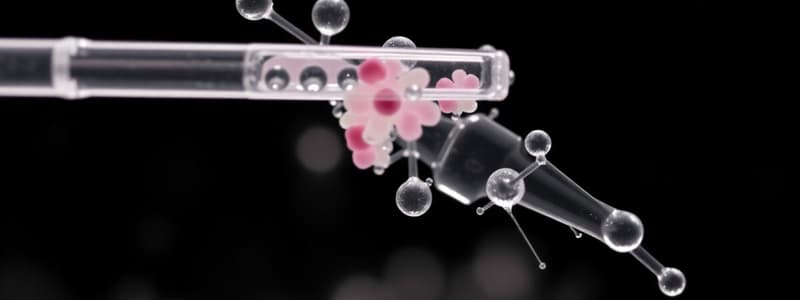Podcast
Questions and Answers
What is the starting material for RT-PCR?
What is the starting material for RT-PCR?
- Messenger RNA (correct)
- Plasmid DNA
- Genomic DNA
- Complementary DNA
Which of the following is a key application of RT-PCR?
Which of the following is a key application of RT-PCR?
- Sequencing of plasmid DNA
- Detection of DNA mutations
- Amplification of genomic DNA
- Analysis of tissue-specific gene expression (correct)
Which reagent is essential for synthesizing cDNA from RNA?
Which reagent is essential for synthesizing cDNA from RNA?
- DNA polymerase
- RNase A
- Oligo (dT)n
- Reverse transcriptase (correct)
How does RT-PCR contribute to gene expression analysis?
How does RT-PCR contribute to gene expression analysis?
What process differentiates RT-PCR from standard PCR?
What process differentiates RT-PCR from standard PCR?
What is one key difference between genomic DNA and cDNA used in PCR?
What is one key difference between genomic DNA and cDNA used in PCR?
Which of the following is an application of RT-PCR?
Which of the following is an application of RT-PCR?
What is the role of the enzyme Taq Polymerase in the cDNA synthesis process?
What is the role of the enzyme Taq Polymerase in the cDNA synthesis process?
How does PCR facilitate gene expression analysis?
How does PCR facilitate gene expression analysis?
Which step in the PCR setup is crucial for allowing primers to bind to the target DNA?
Which step in the PCR setup is crucial for allowing primers to bind to the target DNA?
Which component is necessary for synthesizing cDNA from RNA?
Which component is necessary for synthesizing cDNA from RNA?
What is the primary application of RT-PCR in gene expression analysis?
What is the primary application of RT-PCR in gene expression analysis?
Which step in the PCR program is primarily responsible for denaturing the DNA?
Which step in the PCR program is primarily responsible for denaturing the DNA?
During the annealing step of the PCR process, what is being facilitated?
During the annealing step of the PCR process, what is being facilitated?
What is the purpose of including Taq DNA polymerase in the PCR setup?
What is the purpose of including Taq DNA polymerase in the PCR setup?
What is the final step of the PCR program and its purpose?
What is the final step of the PCR program and its purpose?
cDNA: Reverse transcriptase (RT):
Oligo(dT) primer:
RNase H:
cDNA: Reverse transcriptase (RT): Oligo(dT) primer: RNase H:
reverse transcription
reverse transcription
central dogma
central dogma
pcr by who
pcr by who
pcr
pcr
what is needed for pcr
what is needed for pcr
After each PCR cycle, the amount of DNA doubles.
The amount of amplified DNA at the end of N cycles is ?
After each PCR cycle, the amount of DNA doubles. The amount of amplified DNA at the end of N cycles is ?
designing primers, forward and reverse
designing primers, forward and reverse
Flashcards
PCR Reaction Setup (A)
PCR Reaction Setup (A)
A procedure to amplify the ACTIN1 gene using extracted genomic DNA (gDNA).
PCR Reaction Setup (B)
PCR Reaction Setup (B)
A procedure to amplify the ACTIN1 gene using synthesized cDNA.
Genomic DNA (gDNA)
Genomic DNA (gDNA)
DNA extracted from cells or tissues.
Complementary DNA (cDNA)
Complementary DNA (cDNA)
Signup and view all the flashcards
PCR Primers (At-ACTIN-483F & At-ACTIN-D40-R2)
PCR Primers (At-ACTIN-483F & At-ACTIN-D40-R2)
Signup and view all the flashcards
PCR Thermocycling Steps
PCR Thermocycling Steps
Signup and view all the flashcards
PCR Cycle
PCR Cycle
Signup and view all the flashcards
Target Gene: ACTIN1
Target Gene: ACTIN1
Signup and view all the flashcards
PCR
PCR
Signup and view all the flashcards
PCR Steps
PCR Steps
Signup and view all the flashcards
Primers
Primers
Signup and view all the flashcards
cDNA
cDNA
Signup and view all the flashcards
Reverse Transcription
Reverse Transcription
Signup and view all the flashcards
cDNA
cDNA
Signup and view all the flashcards
Reverse Transcription
Reverse Transcription
Signup and view all the flashcards
RT-PCR
RT-PCR
Signup and view all the flashcards
PCR
PCR
Signup and view all the flashcards
Tissue-specific gene expression
Tissue-specific gene expression
Signup and view all the flashcards
Study Notes
Lab 7: Targeted Amplification from Genomic DNA and cDNA by PCR
- Lab focused on amplifying specific DNA sequences or genes using PCR and RT-PCR methods.
- First-strand cDNA synthesis was performed by reverse transcription.
- Course: BIOL 3120 - Cell Biology Lab
- Instructor: Rubaia Tasmin
- Date: 10/21/2024
Today's Lab Objectives
- Understand the principles of PCR and RT-PCR.
- Learn to design gene-specific primers (using Arabidopsis ACTIN1 as an example).
- Set up and run PCR reactions.
The Central Dogma of Molecular Biology
- DNA replication (DNA → DNA) is catalyzed by DNA Polymerase.
- Transcription (DNA → RNA) is catalyzed by RNA Polymerase from DNA to mRNA.
- Reverse transcription is from RNA to cDNA via reverse transcriptase.
- Translation (RNA → Protein) converts mRNA into proteins. This process occurs in ribosomes.
- Unusual flows of information are highlighted in diagrams.
Genomic DNA Organization for Protein-Coding Genes
- Genes consist of exons (coding sequences) and introns (non-coding sequences).
- Introns are removed from pre-mRNA during RNA splicing.
- Exons remain in mature mRNA and are translated into proteins.
- Diagrams of gene structure and mRNA processing are included.
Polymerase Chain Reaction (PCR)
- Powerful method for amplifying specific DNA sequences.
- Developed by Kary Mulis (1983).
- Nobel Prize awarded in 1993.
- Includes steps: denaturation, annealing, and extension.
- PCR cycles are repeating steps to amplify specific DNA section.
PCR Steps
- Denaturation: (45 sec - 1 min) at 95°C, DNA strands separate.
- Annealing: (45 sec) at 55°C, primers bind to complementary DNA strands.
- Extension: (1 - 1.5 min) at 72°C, DNA polymerase synthesizes new strands.
Contents of a PCR Reaction
- Template DNA.
- Primers (forward and reverse).
- PCR buffer (Tris HCI, KCl, Mg²⁺).
- Deoxynucleotide triphosphates (dNTPs).
- Taq polymerase.
Designing Primers
- Forward primers bind to the bottom strand of DNA.
- Reverse primers bind to the top strand of DNA.
- Primer sequences are provided from 5' to 3' direction.
- Primers are short pieces of single stranded DNA.
- They bind to specific DNA sequences.
Designing Primers for a DNA Segment in ACTIN1 Gene
- Provide sequences of forward and reverse primers (specified as At-ACTIN-483F & At-ACTIN-D40-R2).
PCR Troubleshooting
- Why do primers anneal to the target DNA? High concentration of primers prevents re-hybridization.
- Why does PCR commonly run for 30 cycles? Primers and dNTPs are consumed.
- Why is product length defined by 5' end? Polymerase may extend beyond primer's boundary.
Reverse Transcription (RT) and cDNA synthesis
- cDNA is the complementary DNA copy of mRNA.
- RT-PCR uses mRNA converted to cDNA as a starting material.
- RT reaction involves reverse transcriptase and oligo(dT)n to make cDNA sequence from mRNA.
- RNaseH removes mRNA.
Difference between PCR and RT-PCR
- PCR uses gDNA, RT-PCR uses cDNA which is created from RNA.
- gDNA has introns, cDNA does not.
- RT-PCR is needed to study gene expression.
PCR Reaction Setting-up (A)
- Components: 10X Taq buffer, PCR nucleotides mix, forward and reverse primers, Taq DNA poymerase, genomic DNA and volumes.
PCR Reaction Setting-up (B)
- Components: 10X Taq buffer, PCR nucleotides mix, forward and reverse primers, Taq DNA poymerase, cDNA and volumes.
PCR Program
- Initial Denaturation: 95°C for 2 minutes.
- Denaturation: 94°C for 1 minute.
- Annealing: 59°C for 1 minute.
- Extension: 72°C for 50 seconds.
- Repeat steps 2-4 for 29 cycles.
- Final Extension: 72°C for 10 minutes.
- Storage: 4°C .
Studying That Suits You
Use AI to generate personalized quizzes and flashcards to suit your learning preferences.



